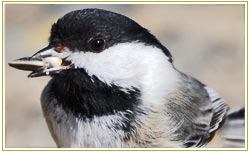About The Carolina Chickadee
 The Carolina chickadee, Parus carolinensis or Poecile carolinensis, is a songbird that can be found south of line extending from southern Kansas to central New Jersey. The Carolina chickadee is small, plump, has a short bill, a very distinctive black “cap on its head, a black “bib” on its throat, and has white cheeks, a grayish-white belly, rusty brown sides, and a gray back. Their short bills are dark and they have short wings but long tails. Adult Carolina chickadees are approximately 4.25 inches in length and are the smallest of the North American chickadees.
The Carolina chickadee, Parus carolinensis or Poecile carolinensis, is a songbird that can be found south of line extending from southern Kansas to central New Jersey. The Carolina chickadee is small, plump, has a short bill, a very distinctive black “cap on its head, a black “bib” on its throat, and has white cheeks, a grayish-white belly, rusty brown sides, and a gray back. Their short bills are dark and they have short wings but long tails. Adult Carolina chickadees are approximately 4.25 inches in length and are the smallest of the North American chickadees.
The Carolina Chickadee Nesting Preferences
The Carolina chickadee lives in forests, groves, wooded areas near ponds, marshes, swamps, and even on farms and towns. They build their nests in abandoned or natural cavities in trees. They also sometimes make their own holes in old trees but also like to live in birdhouses. Carolina chickadees build nests from around 4 to 15 feet from the ground. Excavation and building of nests as well as incubation of eggs are usually primarily done by female chickadees, if not solely by them. The nests are made of fine grass and feathers.
Building a Birdhouse For The Carolina Chickadee
Carolina chickadee nest boxes should be made of wood stock with rough surfaces on both sides to aid the birds’ grip. Recommended dimensions for the nest boxes are: 4” x 4” (floor), 9” (distance from floor to ceiling), ¼ “(diameter of entrance hole), 7” (distance from floor to the hole’s top). Nest boxes should include ventilation holes in the floor and under the roof, be littered with a few wood chips, and have a hinged roof for easy access inside the box. Wood chips are recommended to give the nest box a genuine feel. The nest box should also be mounted at chest level on a tree trunk or limb. Carolina chickadee nest boxes should be removed from the tree trunk after the brood rearing season.
The Carolina Chickadee Mating Habits
Chickadees in general are territorial monogamous pairs. However, there are some instances wherein male chickadees have been observed to have had two mates.
The Carolina Chickadee Feeding Preferences
 The Carolina chickadee’s diet consists mainly of insects, which they catch while hopping along tree branches in the search for food and by hovering around or hanging upside down and making short flights in the air when insects draw near. However, they also like to eat a variety of fleshy fruits, suet, berries, acorns and seeds especially during winter.
The Carolina chickadee’s diet consists mainly of insects, which they catch while hopping along tree branches in the search for food and by hovering around or hanging upside down and making short flights in the air when insects draw near. However, they also like to eat a variety of fleshy fruits, suet, berries, acorns and seeds especially during winter.
Interesting Carolina Chickadee Facts
- Carolina chickadees are able to lower their body temperatures to induce a state of hypothermia. They do this to conserve energy during extremely cold winters. During extremely cold weather conditions they look for cavities where they can hide in and lower their body temperature and stay in a state of hypothermia for up to fifteen hours at a time.
- Carolina chickadees are so similar to black-capped chickadees that they themselves have trouble telling their species apart. Because of this they sometimes mate producing hybrids. The most obvious difference between the three chickadees is that the Carolina chickadee sings four-note song, black-capped ones sing two-note songs, and the hybrids sing three-note songs.